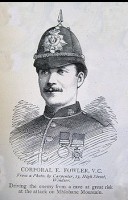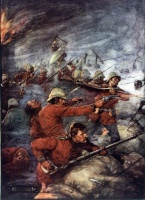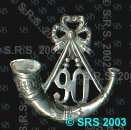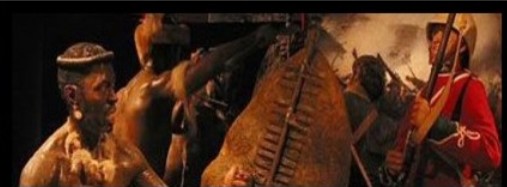| Latest topics | » The Pictorial World - March 15th 1879 Yesterday at 1:13 pm by ben2000 » The lost diary of Pvt James Owen Thu Jul 25, 2024 12:03 pm by miklew » Last of the 24th at Isandhlwana Wed Jul 24, 2024 6:16 pm by John Young » What was the uniform of field marshals/generals in the zulu war? Mon Jul 22, 2024 6:53 am by John Young » Henderson and the NNH at Rorke's Drift  Sat Jul 20, 2024 12:17 pm by SRB1965 » Capt. D. Hayes 1/3rd Regt., NNC Thu Jul 18, 2024 11:11 am by Julian Whybra » The Wrecked Camp Wed Jul 17, 2024 4:33 pm by Julian Whybra » Private N/N John Robert Branch 90th Regiment and his discovered diary Mon Jul 15, 2024 8:53 pm by 1879graves » Private John Scott 24th Regiment a fugitive at large Sun Jul 14, 2024 12:06 pm by 1879graves » 90th foot sgt T. Collins 214 Sun Jul 14, 2024 10:57 am by johnman » Baron Von Steitencron Wed Jul 10, 2024 3:10 pm by Julian Whybra » Sgt Joseph Windridge, Defender of Rorke's Drift - Memorial Tue Jul 09, 2024 3:15 am by 90th » Writing advice Sun Jul 07, 2024 4:04 pm by Julian Whybra » South Africa 1877-79, 1 clasp, 1877-8-9 (4389 Fr. Sergt. S. Smith. O/2. Bde. R.A.) Sun Jul 07, 2024 9:30 am by rai » The trashing of the Zulu monument to the brave warriors at Isandlawana March 12, 2024 has been blamed on scrap metal scavengers. Thu Jul 04, 2024 7:41 pm by ADMIN» The Goodwill Zulu Festival: Celebrating the Welsh and KwaZulu Natal Shared Heritage. Thu Jul 04, 2024 7:27 pm by ADMIN» Any nominal role of G Coy 2/24th regiment  Thu Jul 04, 2024 11:18 am by Wayne » Bassage Diary Thu Jul 04, 2024 9:31 am by Julian Whybra » Prior to Sihayo's Kraal  Thu Jul 04, 2024 9:19 am by 90th » British Fort Locations Thu Jul 04, 2024 3:40 am by 90th » Sergeant 1064 Tom Hick / Hicks G Company 2/24th Regiment Wed Jul 03, 2024 11:05 am by Julian Whybra » A Hungarian soldier in the Zulu War (?) Fri Jun 28, 2024 2:31 pm by Mr M. Cooper » Private 25B/279 Henry Sears Bugler E Company 24th Reg. KIA Isandlwana Thu Jun 27, 2024 1:07 pm by gardner1879 » Hamilton Browne's birthday Fri Jun 21, 2024 9:22 am by Julian Whybra » Zulu "Corps" Thu Jun 20, 2024 6:01 pm by Hobbes » Army Pay Department Personnel Thu Jun 20, 2024 11:49 am by Julian Whybra » Ntshingwayo birth date Sun Jun 16, 2024 11:37 am by Hobbes » Zibhebhu and Cetshwayo's family Wed Jun 05, 2024 9:11 pm by Julian Whybra » Smith's Store/Hotel Wed Jun 05, 2024 6:06 pm by Julian Whybra » Corporal James Frowen Williams F Company.  Tue Jun 04, 2024 5:20 pm by Julian Whybra » Shaka iLembe Sat Jun 01, 2024 1:27 pm by Jon84 » Bugler 1415 Thomas Finn / Flin 90th Regiment  Sat May 25, 2024 11:28 am by johnman » Inspector-General Evelyn Richard Hugh Pollard Tue May 14, 2024 10:13 am by ADMIN» Alfred Fairlie Henderson photographs. Sat May 11, 2024 8:01 am by Julian Whybra » Fairlie's Native Police Thu May 02, 2024 9:12 pm by Hobbes |
| July 2024 | | Mon | Tue | Wed | Thu | Fri | Sat | Sun |
|---|
| 1 | 2 | 3 | 4 | 5 | 6 | 7 | | 8 | 9 | 10 | 11 | 12 | 13 | 14 | | 15 | 16 | 17 | 18 | 19 | 20 | 21 | | 22 | 23 | 24 | 25 | 26 | 27 | 28 | | 29 | 30 | 31 | | | | |  Calendar Calendar |
|
| Top posting users this month | |
| New topics | » The Pictorial World - March 15th 1879 Yesterday at 1:13 pm by ben2000 » The lost diary of Pvt James Owen Thu Jul 25, 2024 12:03 pm by miklew » Last of the 24th at Isandhlwana Wed Jul 24, 2024 5:53 pm by miklew » What was the uniform of field marshals/generals in the zulu war? Sun Jul 21, 2024 12:30 pm by darthvaix » Henderson and the NNH at Rorke's Drift  Fri Jul 19, 2024 1:29 pm by SRB1965 » Capt. D. Hayes 1/3rd Regt., NNC Wed Jul 17, 2024 10:52 pm by Julian Whybra » The Wrecked Camp Sun Jul 14, 2024 8:51 am by 61MECH » The trashing of the Zulu monument to the brave warriors at Isandlawana March 12, 2024 has been blamed on scrap metal scavengers. Thu Jul 04, 2024 7:41 pm by ADMIN» The Goodwill Zulu Festival: Celebrating the Welsh and KwaZulu Natal Shared Heritage. Thu Jul 04, 2024 7:27 pm by ADMIN |
| Zero tolerance to harassment and bullying. | |
Due to recent events on this forum, we have now imposed a zero tolerance to harassment and bullying. All reports will be treated seriously, and will lead to a permanent ban of both membership and IP address.
Any member blatantly corresponding in a deliberate and provoking manner will be removed from the forum as quickly as possible after the event.
If any members are being harassed behind the scenes PM facility by any member/s here at 1879zuluwar.com please do not hesitate to forward the offending text.
We are all here to communicate and enjoy the various discussions and information on the Anglo Zulu War of 1879. Opinions will vary, you will agree and disagree with one another, we will have debates, and so it goes.
There is no excuse for harassment or bullying of anyone by another person on this site.
The above applies to the main frame areas of the forum.
The ring which is the last section on the forum, is available to those members who wish to partake in slagging matches. That section cannot be viewed by guests and only viewed by members that wish to do so. |
| Fair Use Notice | | Fair use notice.
This website may contain copyrighted material the use of which has not been specifically authorised by the copyright owner.
We are making such material and images are available in our efforts to advance the understanding of the “Anglo Zulu War of 1879. For educational & recreational purposes.
We believe this constitutes a 'fair use' of any such copyrighted material, as provided for in UK copyright law. The information is purely for educational and research purposes only. No profit is made from any part of this website.
If you hold the copyright on any material on the site, or material refers to you, and you would like it to be removed, please let us know and we will work with you to reach a resolution. |
| | | Farrier's axe |  |
| | | Author | Message |
|---|
horsefixer
Posts : 37
Join date : 2010-07-25
 |  Subject: Farrier's axe Subject: Farrier's axe  Thu Jul 11, 2013 8:11 pm Thu Jul 11, 2013 8:11 pm | |
| Can anyone tell me if they used the farrier's axe to put down horses in the AZ war and if so a description.
Thanks |
|   | | littlehand

Posts : 7076
Join date : 2009-04-24
Age : 55
Location : Down South.
 |  Subject: Re: Farrier's axe Subject: Re: Farrier's axe  Thu Jul 11, 2013 9:07 pm Thu Jul 11, 2013 9:07 pm | |
| I don't think so. The British used to shoot cattle rather than letting the Natives kill them in there usual custom, so my guess it's they shot the horses. We know veterinary surgeons we're available, so they may have had an intervention? |
|   | | littlehand

Posts : 7076
Join date : 2009-04-24
Age : 55
Location : Down South.
 |  Subject: Re: Farrier's axe Subject: Re: Farrier's axe  Thu Jul 11, 2013 9:26 pm Thu Jul 11, 2013 9:26 pm | |
| Extract Sgt R. Smith 1st Kings Dragoons Guards
While in Rorkes Drift I assisted the butcher to kill meat bullocks and sheep. The beasts were good, the sheep about two stone weight. Anyone could carry about three couples on a rabbiting spade shaft. We had a herd of cattle come at a time and the natives would mind them for their scoff (or meat) which was all the spare tack, they do not leave anything but the skin and bone eating all the inside as it is, in the raw state without any washing. Every morning these natives would bring up the herd and then someone (generally officers) would shoot down as many as was wanted perhaps four sometimes more for we had to shoot them for our niggers on account of their way of slaughtering. The way they kill is with the assegais as the cattle keeps running round the butcher throws these assegais until it drops sometimes having half-a-dozen or more before falling and our Colonel in Command seeing this gave us the order to shoot them.
|
|   | | horsefixer
Posts : 37
Join date : 2010-07-25
 |  Subject: Re: Farrier's axe Subject: Re: Farrier's axe  Thu Jul 11, 2013 9:28 pm Thu Jul 11, 2013 9:28 pm | |
| Hmm, not too sure. They were still using the axe in WW1 so I'm leaning towards them having used it in the Zulu War but I need to be sure as this is going in a book I am writing |
|   | | littlehand

Posts : 7076
Join date : 2009-04-24
Age : 55
Location : Down South.
 |  Subject: Re: Farrier's axe Subject: Re: Farrier's axe  Thu Jul 11, 2013 9:48 pm Thu Jul 11, 2013 9:48 pm | |
| OK I will see what I can find! |
|   | | kwajimu1879

Posts : 420
Join date : 2011-05-14
 |  Subject: Re: Farrier's axe Subject: Re: Farrier's axe  Fri Jul 12, 2013 4:40 pm Fri Jul 12, 2013 4:40 pm | |
| Horsefixer,
The two regular units of British cavalry would have had the farrier's axe.
I imagine it would have been the same pattern as that still carried by the Household Cavalry, I would offer to check my books on the subject but we have decorators in at present.
'Jimu |
|   | | impi

Posts : 2308
Join date : 2010-07-02
Age : 44
 |  Subject: Re: Farrier's axe Subject: Re: Farrier's axe  Fri Jul 12, 2013 4:47 pm Fri Jul 12, 2013 4:47 pm | |
| |
|   | | 90th

Posts : 10890
Join date : 2009-04-07
Age : 68
Location : Melbourne, Australia
 |  Subject: Farrier's Axe Subject: Farrier's Axe  Fri Jul 12, 2013 5:10 pm Fri Jul 12, 2013 5:10 pm | |
| Hi Horsefixer .
I see on impi's post the Farrier Axe is dated c 1800 - 40 , I've read many books on the AZW and have never come across the Farrier Axe , which doesn't mean that it wasnt used in 1879 , if it was used , it may have been used back behind the lines . All the horses that needed to be put down while in zululand , were shot from all the accounts that I've read .
90th. |
|   | | kwajimu1879

Posts : 420
Join date : 2011-05-14
 |  Subject: Re: Farrier's axe Subject: Re: Farrier's axe  Fri Jul 12, 2013 6:17 pm Fri Jul 12, 2013 6:17 pm | |
| 90th,
I saw a colleague of mine try to put a wounded horse out of its misery with .38 pistol, he had to reload it after emptying six rounds into its head, the farrier had to do the job with the spike of his axe. My unit then got sent on a course on where to shoot a horse in the head to put it down.
There's famous painting at the National Army Museum, Chelsea, entitled 'Cruel to be Kind' painted by R. Caton Woodville in 1882, showing a cavalry officer about to pistol a wounded horse in the 2nd Afghan War, but he had the advantage of having a .45 pistol.
'Jimu |
|   | | ADMIN

Posts : 4354
Join date : 2008-11-01
Age : 65
Location : KENT
 |  Subject: Re: Farrier's axe Subject: Re: Farrier's axe  Fri Jul 12, 2013 7:25 pm Fri Jul 12, 2013 7:25 pm | |
| |
|   | | ADMIN

Posts : 4354
Join date : 2008-11-01
Age : 65
Location : KENT
 |  Subject: Re: Farrier's axe Subject: Re: Farrier's axe  Sat Jul 13, 2013 9:57 am Sat Jul 13, 2013 9:57 am | |
| |
|   | | | | Farrier's axe |  |
|
| | Permissions in this forum: | You cannot reply to topics in this forum
| |
| |
| |
